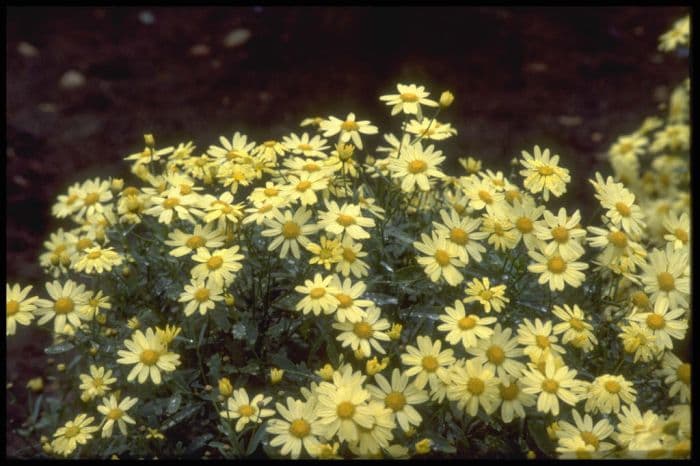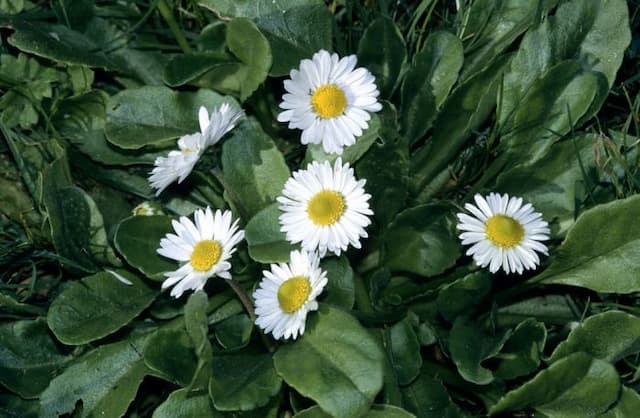Marguerite Daisy Argyranthemum maderense

ABOUT
Argyranthemum maderense, commonly known as Marguerite Daisy, is a flowering plant distinguished by its daisy-like flowers. The flowers are generally vibrant, with a central disc of tiny, tubular florets which are typically yellow in color, surrounded by a starburst of slender petals that tend to be white. The leaves of Marguerite Daisy are deeply lobed, giving them a fine-textured appearance, and are typically a lush green shade. These leaves may also have a somewhat furry or velvety texture to touch. Marguerite Daisy exhibits a bushy growth habit, with the foliage and flowers creating an overall impression of a mounded form. The overall display of the plant is one that is quite showy, making it a popular choice for gardeners who desire a bright and cheerful bloom during its flowering season.
About this plant
 Names
NamesSynonyms
Madeira Marguerite, Madeira Daisy, Paris Daisy
Common names
Chrysanthemum frutescens var. maderense, Ismelia maderensis, Pyrethrum frutescens var. maderense.
 Toxicity
ToxicityTo humans
Marguerite daisy (Argyranthemum maderense) is not commonly known to be toxic to humans. There are no well-documented cases of poisoning from consuming or coming into contact with this plant. However, as with many plants, it is possible for individuals to experience allergic reactions or skin irritation. If ingested in large quantities, it might cause stomach upset or discomfort due to the presence of different plant compounds, but this is not typically severe or life-threatening. To ensure safety, it is always best to avoid eating plants that are not specifically grown or identified as safe for human consumption.
To pets
Marguerite daisy (Argyranthemum maderense) is not widely recognized as a toxic plant to pets. There is limited information about its effects on domestic animals, and it does not appear on lists of common toxic plants for pets by major animal health organizations. Nonetheless, pets might still experience mild gastrointestinal upset if they consume large amounts of the plant, as their bodies are not adapted to digesting large quantities of plant material. Symptoms of such non-specific gastrointestinal upset may include vomiting and diarrhea. If a pet exhibits any signs of distress after consuming part of this plant, it is advisable to contact a veterinarian.
 Characteristics
CharacteristicsLife cycle
Perennials
Foliage type
Evergreen
Color of leaves
Green
Flower color
Yellow
Height
3 feet [0.91 meters]
Spread
3 feet [0.91 meters]
Plant type
Shrub
Hardiness zones
10
Native area
Canary Islands
Benefits
 General Benefits
General Benefits- Ornamental Appeal: Argyranthemum maderense, commonly known as Marguerite Daisy, offers decorative blooms that enhance garden aesthetics with their cheerful daisy-like flowers.
- Pollinator Attraction: The flowers attract a variety of pollinators, including bees and butterflies, contributing to the biodiversity of the ecosystem.
- Easy to Grow: Marguerite Daisies are relatively easy to care for, making them suitable for novice gardeners or those with limited gardening experience.
- Drought Tolerance: Once established, they can tolerate periods of drought, reducing the need for frequent watering and making them ideal for xeriscaping.
- Variety of Uses: They can be used in multiple garden settings such as borders, containers, and as cut flowers due to their long stems and vibrant appearance.
- Long Blooming Period: Marguerite Daisies have a long blooming season, often from spring through to fall, providing extended color and interest in the garden.
- Erosion Control: When planted in groups, they can help stabilize soil and prevent erosion on slopes or in areas with loose soil.
 Medical Properties
Medical PropertiesThis plant is not used for medical purposes.
 Air-purifying Qualities
Air-purifying QualitiesThis plant is not specifically known for air purifying qualities.
 Other Uses
Other Uses- Butterfly Gardening: Marguerite daisy can attract various species of butterflies due to its bright and showy flowers, making it a valuable addition to butterfly gardens.
- Photography Prop: The vibrant flowers of the marguerite daisy make it an excellent subject for photography, adding a pop of color to garden or nature-inspired photo shoots.
- Educational Tool: Marguerite daisy can be used in educational settings such as schools or botanical gardens to teach about plant biology, especially pollination and flowering plant life cycles.
- Companion Planting: This plant can be used in companion planting to enhance the growth of vegetables by attracting beneficial insects and providing a splash of color in the vegetable garden.
- Seasonal Decor: Due to its seasonal bloom, the marguerite daisy can be used for making wreaths or other floral arrangements for spring and summer events.
- Culinary Garnish: While not commonly eaten, the petals of the marguerite daisy can be used as an edible garnish for salads, desserts, and drinks for a decorative touch.
- Art Projects: The distinctive form and color of marguerite daisy flowers can be used in art projects like flower pressing or botanical illustration.
- Landscape Design: With its tidy habit and ample bloom, it can serve as an accent plant in coastal-themed landscape designs.
- Fabric Dyeing: Historically, some daisy species have been used to create natural dyes; marguerite daisy flowers may lend themselves to such use, offering shades of yellow or green.
- Craft Materials: Dried marguerite daisy flowers can be used in crafts such as potpourri, homemade paper, or as natural decorations in candles and soaps.
Interesting Facts
 Feng Shui
Feng ShuiThe Marguerite daisy is not used in Feng Shui practice.
 Zodiac Sign Compitability
Zodiac Sign CompitabilityThe Marguerite daisy is not used in astrology practice.
 Plant Symbolism
Plant Symbolism- Radiance: Argyranthemum maderense, commonly known as the Marguerite daisy, often symbolizes radiance due to its brightly colored, sun-like flowers that tend to brighten up any garden space.
- Innocence: Similar to other daisy varieties, the Marguerite daisy is often associated with purity and innocence, reflecting the simple beauty and unspoiled nature of the bloom.
- Cheerfulness: The Marguerite daisy represents cheerfulness, with its happy-looking flowers and its ability to lift spirits, it's often given to bring joy to someone’s day.
- Patience: Representing the value of patience, the Marguerite daisy blooms over a period of time, symbolizing the ability to wait for the good to unfold.
 Water
WaterFor the Marguerite Daisy, it is critical to water thoroughly when the top inch of soil becomes dry to the touch. This typically means watering once a week, but may increase to twice per week during hot, dry spells. When watering, aim to provide enough water to moisten the soil to a depth of about 6 inches, which may be approximately 0.5 to 1 gallon depending on plant size and pot. Avoid overhead watering to prevent foliar diseases—water at the base of the plant instead. In winter, reduce watering frequency to prevent waterlogging as the plant's growth slows down.
 Light
LightMarguerite Daisy thrives best in full sun conditions where it can receive at least 6 to 8 hours of direct sunlight daily. Place it in a location where sunlight is abundant; a south-facing spot is ideal for maximum light exposure. However, in extremely hot climates, some afternoon shade is beneficial to prevent scorching.
 Temperature
TemperatureThe Marguerite Daisy prefers a temperate climate with temperatures ranging between 50°F and 75°F. While it can tolerate a minimum temperature of about 30°F, frost can damage the plant, and a maximum temperature of 80°F to 85°F shouldn't be exceeded for extended periods. To ensure optimal growth, maintain the ideal temperature range and protect the plant from temperature extremes.
 Pruning
PruningPrune Marguerite Daisy to maintain its shape and encourage bushier growth with more blooms. Deadheading spent flowers promotes continuous blooming and prevents the plant from using energy to form seeds. Cut back the plant by one-third in late summer to rejuvenate and prepare for a flush of fall blooms. The best time for pruning is after a wave of flowering has ended.
 Cleaning
CleaningAs needed
 Soil
SoilMarguerite Daisy prefers well-draining soil with a mix of potting soil, peat, perlite, and sand, ensuring good aeration and drainage. The ideal soil pH for Marguerite Daisy should be slightly acidic to neutral, ranging from 6.0 to 7.0.
 Repotting
RepottingMarguerite Daisy should be repotted once every 1-2 years, or when the plant outgrows its current pot, to ensure it has enough room for root growth and to replenish nutrients in the soil.
 Humidity & Misting
Humidity & MistingMarguerite Daisy thrives in moderate humidity levels. Aim to maintain the ambient humidity around 40-50% for optimal growth, as excessively high humidity can invite fungal issues.
 Suitable locations
Suitable locationsIndoor
Place Marguerite Daisy in a bright spot with some direct sun indoors.
Outdoor
Plant in full sun, protect from strong winds, and water regularly.
Hardiness zone
9-11 USDA
 Life cycle
Life cycleThe Marguerite Daisy (Argyranthemum maderense) begins its life cycle as a seed, which upon finding favorable conditions, germinates and sprouts into a small seedling. The seedling then develops into a juvenile plant, producing a rosette of leaves and establishing a root system. As it matures, the plant enters the vegetative stage, where it undergoes rapid growth and foliage development. Following this, the Marguerite Daisy reaches the flowering stage, where it produces daisy-like flower heads composed of central disc florets and surrounding ray florets, attracting pollinators for sexual reproduction. After pollination, the flowers develop into seed heads, containing seeds that will disperse and potentially give rise to new plants. The plant completes its life cycle with senescence, where it eventually declines and dies, although some may survive as perennials in suitable climates.
 Propogation
PropogationPropogation time
Spring-Early Summer
Propogation: The Marguerite daisy, scientifically known as Argyranthemum maderense, is commonly propagated through cuttings. This approach is favored for its efficiency and ability to produce plants identical to the parent. To propagate by cuttings, a healthy parent plant is selected during the active growth period, which is generally in the spring or early summer. A stem cutting of about 4 to 6 inches (10 to 15 centimeters) in length is taken, ideally with several sets of leaves. The bottom leaves are removed, and the cut end is dipped in a rooting hormone to encourage root development. The cutting is then inserted into a well-draining soil mix and kept moist until roots have established, which typically takes a few weeks. During this time, it's important to maintain a consistent temperature and humidity to ensure successful rooting.









